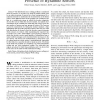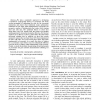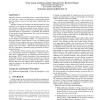130 search results - page 11 / 26 » How to Encrypt with a Malicious Random Number Generator |
CORR
2007
Springer
13 years 7 months ago
2007
Springer
—The distributed source coding problem is considered when the sensors, or encoders, are under Byzantine attack; that is, an unknown group of sensors have been reprogrammed by a m...
JDCTA
2010
13 years 2 months ago
2010
In visual cryptography, the secret can be any written text, graphical representation, or picture. This technique, some time called visual secret sharing (VSS), allows visual infor...
ACSAC
2009
IEEE
14 years 2 months ago
2009
IEEE
—We take a systematic approach to developing a symmetric cryptography library in Javascript. We study various strategies for optimizing the code for the Javascript interpreter, a...
ICSE
2008
IEEE-ACM
14 years 8 months ago
2008
IEEE-ACM
Intuition is often not a good guide to know which testing strategies will work best. There is no substitute for experimental analysis based on objective criteria: how many bugs a ...
IJISEC
2010
13 years 6 months ago
2010
Physical Unclonable Functions (PUFs) are physical objects that are unique, practically unclonable and that behave like a random function when subjected to a challenge. Their use h...



